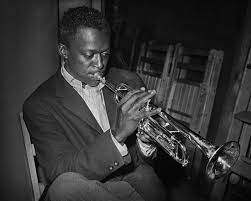The Miles Davis session known as Walkin’ has long been heralded as the harbinger of Hard Bop to come, and as one of Davis’s greatest recorded performances. Martin Williams, Dick Katz, Whitney Balliett, and other critics praised it, and Davis himself recognized it as a watershed. Recorded in the spring of 1954, the date consisted of extended performances of two blues themes, Dizzy Gillespie’s “Blue ‘n’ Boogie,” and the title track, a tune credited to a Chicago hustler named Richard Carpenter, but actually composed by Jimmy Mundy and recorded by Gene Ammons as “Gravy.”

1954 was a pivotal year in Davis’s career. The 28-year-old trumpeter had gone home to St. Louis the preceding summer to kick his heroin habit. Following brief periods spent tuning up in Chicago and Detroit, he returned to New York refreshed and poised for the success he’d soon realize through his recordings for Prestige; his celebrated appearance at Newport in 1955; a contract with Columbia; and the formation of his famous quintet with John Coltrane. Miles’s first date back was a quartet session for Blue Note that produced six titles including “Weirdo,” a three-note blues theme that Miles would revisit four years later under the title, “Sid’s Ahead.” The tune’s simple melodic line and slow tempo afforded the trumpeter a chance to stretch out and dig deep into the bluesy lyricism that would become a hallmark of his work throughout the ‘50’s and ‘60’s. In both “Weirdo” and “Walkin’,” the seeds not only of Hard Bop, but of Davis’s modal blues masterpiece, Kind of Blue, were being planted.
As a member of Charlie Parker’s Quintet in the ‘40’s, Miles was as mindful as anyone of the long road jazz had taken from Swing Era populism to post-War modernism, and of the challenges that bebop’s white heat velocity presented to a player of such lyrical gifts as his own. Davis’s first attempt at an exit strategy from bop was the music he created with Gil Evans, Gerry Mulligan, and John Lewis that came to be known as the Birth of the Cool. But this proved to be a half-measure, and Cool’s influence on California-based jazzmen who enjoyed popularity by de-emphasizing blues tonality and emotional expressiveness in favor of melodically-rich suppleness epitomized the East Coast/West Coast dichotomy that gripped jazz in the 50’s.
Just as Miles led the way to Cool, he blazed a hot new trail out of it with a reassertion of first principles, and they all came together with his All-Stars date of April 29, 1954. Martin Williams wrote of the period as a demarcation point in which “the overtly complex harmonic challenges…were behind Davis. He was interested in a direct building up of melodic content, and he had learned to make pause, silence, and space a crucially expressive part of his musical language. Beginning now, one passionate note from Miles seemed to imply a whole complex of expressive sound, and three notes a ravishing melody.” Coincidentally, during this same month, the trumpeter began making extensive use of the Harmon mute, a devise that enhanced the introspective lyricism at the core of his art, but on declarative works like “Walkin’” and the later blues themes “So What,” “Freddie Freeloader,” and “No Blues,” he played open horn exclusively.
In Miles: The Autobiography, the trumpeter said of Walkin’, “I wanted to take the music back to the fire and improvisations of bebop…But also I wanted to take the music forward into a more funky kind of blues…I did Walkin’ for Prestige, and man, that album turned my whole life and career around. I got J.J. Johnson and Lucky Thompson for that session because I wanted that big sound that both of them could give me. You know, Lucky for that Ben Webster thing, but a bebop thing, too. J.J. had that big sound and tone, and then we Percy Heath on bass, [Kenny Clarke] on drums, and Horace on piano. We worked out all the concepts for the music in my room and Horace’s room at the Arlington Hotel [where both resided]. A lot of that…came right out of Horace’s old upright piano. We knew when we finished that session that we had something good…but we didn’t really feel the impact of that album until it was released later that year…It was something else.”
Here’s a 1967 performance of “Walkin’” by the Davis Quintet with Wayne Shorter, Herbie Hancock, Ron Carter, and Tony Williams. It’s faster, louder and less lyrical than the original, but 13 years later, it was still a staple of the Davis repertoire.